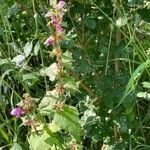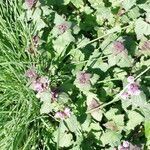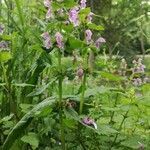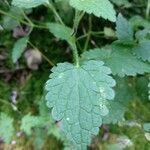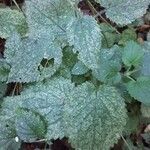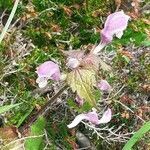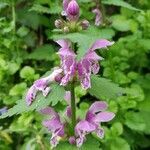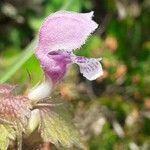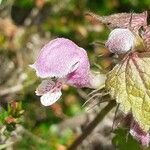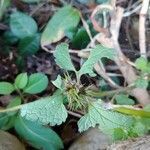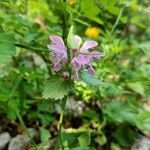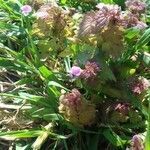Rhizomatous perennial, lax and tending to creep at the base, 1.5–7 dm, somewhat hirsute; lvs all petiolate, with cordate-ovate or triangular-ovate, crenate-serrate blade 1.5–6 × 1–5 cm, generally with an irregular broad white stripe about the midvein; verticils several, less crowded than in no. 3 [Lamium purpureum L.], the lower subtended by full-sized lvs, the upper by smaller and less petiolate ones; cal 5–10 mm, with firm, unequal, somewhat divaricate slender lobes; cor pink-purple (white), 2–3 cm, the tube curved, hairy outside and with a ring of hairs inside, the upper lip 7–12 mm, the lateral lobes each with a single terminal tooth; 2n=18. Native of Europe and adj. Asia, escaped from cult. on roadsides and waste places; e. Can. to Va. and W.Va. Apr.–Sept.
Rhizomatous perennial, lax and tending to creep at the base, 1.5–7 dm, somewhat hirsute; lvs all petiolate, with cordate-ovate or triangular-ovate, crenate-serrate blade 1.5–6 × 1–5 cm, generally with an irregular broad white stripe about the midvein; verticils several, less crowded than in no. 3 [Lamium purpureum L.], the lower subtended by full-sized lvs, the upper by smaller and less petiolate ones; cal 5–10 mm, with firm, unequal, somewhat divaricate slender lobes; cor pink-purple (white), 2–3 cm, the tube curved, hairy outside and with a ring of hairs inside, the upper lip 7–12 mm, the lateral lobes each with a single terminal tooth; 2n=18. Native of Europe and adj. Asia, escaped from cult. on roadsides and waste places; e. Can. to Va. and W.Va. Apr.–Sept.
A herb. It keeps growing from year to year. The stems are 30-50 cm tall. They have some white hairs and are hollow. The leaves are 3-5 cm long by 2-3 cm wide. They are green with blue-silver mottling. The flowers are pink.
